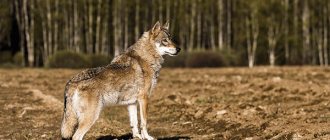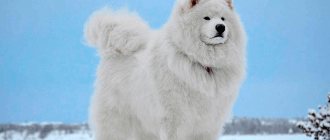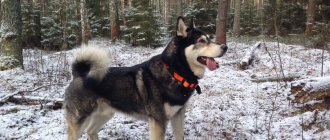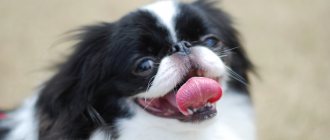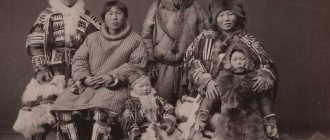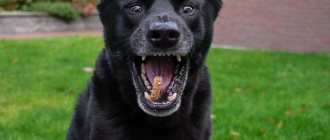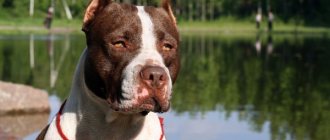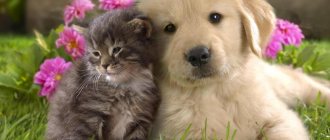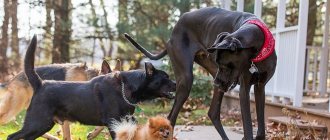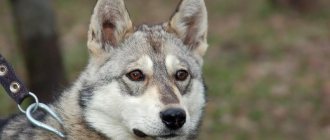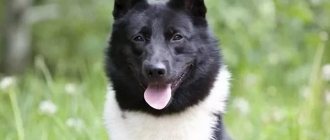Laikas are considered one of the best hunting dogs, and they are almost universal. Their prey can be a large predator such as a bear, a duck, an elk, or any fur-bearing animal. But some hunters think that the breed lacks the instincts and agility of a wild animal.
Experiments on crossing huskies and wolves are carried out quite often by professional dog handlers and amateurs. But are such offspring really superior to their parents in characteristics and abilities?
Story
In ancient times, crossing wolves with domesticated dogs was considered the norm. In this way, in those days they improved the breed, making it more aggressive. Sled dogs also often descended from wolves or had wolf blood in their genes.
It is believed that such a brood is hardier and stronger, but is this really so? The history of the husky confirms the theory that the descendants of wolves are truly hardy, strong and agile.
The theory says that the influx of wolf blood only benefits the dogs’ already hunting ability. But in order to say for sure, a number of observations should be made. When in 1972 a she-wolf, accustomed to people from infancy, gave birth to a gray husky, the babies were closely monitored.
The puppies grew up noticeably behind their purebred peers. They did not go to people, refused to follow commands, were very timid, and even if they had improved characteristics, this remained unnoticeable due to their complete isolation and reluctance to make contact with people.
Surprisingly, history practically repeated itself with the offspring of these hybrids. The puppies that were born thanks to the crossing of the first generation hybrids looked almost as intimidated and were completely unsuitable for work and training.
If the previous generation was completely similar to wolves both in appearance and behavior, then the second experiment produced very diverse offspring, both in coat color and in the level of development of the puppies. But in general, this option was not suitable for hunting, training and activities. They behaved independently, refused to listen to commands and were completely uncontrollable by humans.
One could already conclude that this experiment was unsuccessful and the infusion of wolf blood does not give anything to the already successful breed of dogs, but the third generation litter gave completely different results. This time it was possible to work with the kids, and they showed a small level of learning ability, but these were already good indicators. As for the data, their hearing, smell and vision actually improved. This time we managed to get a more talented and gifted hunting dog.
To read: English black cocker spaniel care and maintenance rules
The result in the fourth generation exceeded all expectations and showed that all this was not in vain. The pets were practically no different in appearance from huskies; they were trainable, intelligent, energetic, and capable. All their animal instincts are more acute, their reaction speed and movement are improved.
We can conclude that in this way there really is a chance to make hunting dogs even more effective and perfect animals, but such a process is too painstaking. It requires a lot of time and effort with no guarantee of success.
Maintenance and care
Walking outdoors is something that should be done every day.
People who are planning to get a Saarloss Wolfdog should become familiar with how to properly keep one. Saarloos care is carried out as follows:
- The Saarloh dog needs to be brushed once a week.
- It is recommended to bathe your pet only in spring or summer. This should be done 1-2 times a month.
- Walking should be done daily. You need to walk for at least two and a half hours.
- Your pet's ears should be checked daily and cleaned of accumulated wax and dirt.
- The claws are trimmed with a special nail clipper. This should be done once every 2-3 months.
- Teeth brushing is done twice a week. For this purpose, a special paste for dogs with the taste of fish or meat is used.
- The eyes are checked daily and debris removed if necessary.
- It is necessary to train and educate a dog from an early age. He should be trained not only in basic commands, but also in recognizing the smells of substances. If the dog is used for hunting purposes, it is taught to detect the scent of prey.
- Physical activity should be regular. Without them, animals' immunity weakens and they begin to get sick.
Woland, description of the breed
So, let’s summarize all of the above and note the positive and negative characteristics that the hybrid of the fourth and subsequent generations is endowed with.
- Outwardly, such a litter is completely similar to dogs and it is almost impossible to distinguish them.
- They are better developed.
- Better developed vision.
- They have an excellent sense of smell.
- Their movement speed is actually faster.
- They are easy to train and are capable of hunting.
You must understand that such a breed does not exist. These are just experiments by dog handlers, who are often also big fans of hunting. It is extremely difficult to breed such a breed and even more difficult to legalize it.
They are not evil by nature, are very attached to people and need communication, but to be completely sure of how and in what situation a wolf descendant will behave, many more observations should be made.
Life expectancy, major diseases and vaccinations
Cataracts are one of the most common diseases of dogs.
Dogs that are not sick with anything can live more than twenty years. However, sometimes their lifespan is reduced significantly due to illness. The most common diseases of this breed include:
- glaucoma;
- fiber atrophy;
- myelopathy;
- cataract;
- vertebral spondylosis.
Important! To strengthen your immune system and prevent diseases, you need to get vaccinated. It is necessary to vaccinate from an early age so that dogs do not get sick.
Hunting
If you ever want to read stories about wolf-dog hunting, go to any hunting forum and you'll encounter some serious discussion.
On the one hand, you will read stories about how to properly raise such an individual, and that there is and cannot be anything dangerous in it, it is led by the fourth or even fifth generation - these are already domesticated dogs.
On the other hand, there are a lot of prejudices regarding the fact that it is impossible to make nature subject to human control and wild instincts will still win. It is possible that there really are successful specimens, but we will list the disadvantages that hunters have encountered:
- At the most important moment, the pet may show cowardice and run away.
- They have a very unstable psyche. There was a case when an angry animal, having lost its game, rushed at the hunter.
- Tendency to unexpected aggression.
- Having caught the prey, the pet simply tore it to pieces.
How important such experiments are is for the canine federations to judge, not you and me, but the fact that official data does not exist makes it difficult to obtain reliable information. There are too many rumors and legends, subjective opinions and rash conclusions floating around the history of hybrids.
To read: Review of the best model haircuts for Yorkie girls: prices for grooming and hairstyles
Mating
It is necessary to breed and produce offspring of Sarlos dogs after the physiological maturity of the animals. In females, the period of maturity begins at the age of 10-12 months. Males mature 2-3 months later. When mating animals, you must adhere to the following recommendations:
- before mating, animals must be treated in advance for parasites;
- It is recommended to breed bitches no more than once a year;
- for mating, only healthy dogs, without diseases, should be used;
- Mating takes place two weeks before the start of estrus.
Important! Animals should only be kept in a quiet place, without extraneous noise.
Why the breed is not recommended as a pet
Although there are examples in the world of successfully keeping pets that are a cross between a wolf and a dog, they are rare. Much more common are stories of keeping half-breeds that ended in tears. Therefore, all over the world, biologists and dog handlers are against the thoughtless and irresponsible ownership of such animals.
When a pet is kept in conditions inappropriate for its mental and physical development, there is always a risk to human safety. It is unacceptable to put a wolf-dog on a chain or lock it in a cramped cage - all this embitters the pet and makes it aggressive and dangerous to others. Every year thousands of half-blooded wolves die, whose owners were not ready to create the necessary conditions for their maintenance and care.
Owners ask veterinarians to euthanize their pets when they grow up and show a “wolfish disposition.” At best, animals can be saved if there is a shelter willing to take them in. Re-adopting such a pet into a family is very problematic. Compounding this problem is the fact that no rabies vaccine has been developed for the hybrid species. The usual vaccination against this deadly disease does not work on a cross between wolves and dogs.
Russian Wolfhund - black wolfdog, the largest of their hybrids
Mix of wolf and husky
Choosing a puppy
It is necessary to buy puppies only from specialized nurseries. You cannot purchase such animals by hand, as this is quite unsafe - you can buy an uncontrollable and aggressive dog.
When choosing a puppy, you need to pay attention to its appearance. The pet should not look sick. You also need to find out information about the puppy’s parents. You should not buy dogs that show aggression from an early age.
How to name
When choosing a dog name, you need to adhere to the following rules:
- you need to choose nicknames that will be well recognized;
- you should not choose a complex name, it should be one or two syllables;
- the name must not be similar to the name of a particular team;
- Don't call dogs by human names.
Important! The chosen nickname should be easy to pronounce.
Appearance of a wolf-dog
Hachiko: the breed, what is the name of the dog that starred in the film
There is no official standard as these amazing animals are not recognized internationally. So far, Russian wolf-dogs are only making their first attempt to gain the status of an independent breed.
Although it is possible to identify certain features inherent in such animals:
- Average weight – 40-50 kg. However, the pet looks more massive due to its lush fur. Among the representatives there are also real giants, weighing more than 70 kg.
- The average height at the withers is 60-70 cm.
- The body is muscular and proportional. With a straight back, long powerful limbs and a long, thick tail placed high.
- The head is medium in size, with erect ears, slanted eyes and a characteristic wolf-like muzzle.
- The teeth are very sharp; a bite from such a dog can cause serious injury. If he wants, it won’t be difficult for him to gnaw off the offender’s neck.
Behind the charming appearance of wolfdogs lies a wild character
There are several color options, but the most common are:
- The classic “wild” dog, thanks to which the wolfdog looks like its predatory ancestors.
- The Canadian black wolfdog looks menacing; with a certain amount of imagination, it resembles a werewolf or a wolf that has just come out of the forge and is stained with soot.
- White color is allowed, but not snow-white, but dirty.
The fur of these hybrid animals is very hard and consists of guard hairs, but the undercoat is soft and lush. The eye color is brown or amber, the nose is always black.
Important! Males are much heavier and more massive than females.
Wolfdog Character Traits
A wolf dog is not the easiest pet to keep. Metis has not been fully studied, so any communication with him is allowed only to experienced dog handlers who have practice in training and socializing “complex” breeds. But you shouldn’t think that this dog consists only of shortcomings.
Beethoven (dog): what breed, what is it called
Character strengths include:
- Amazing mental abilities and ingenuity.
- Obedience. But this parameter is relative - half dog, half wolf will obey only those whom it considers higher than itself in the hierarchy. If the owner for some reason has lost authority, the wolfdog will stop following his commands.
- Courage. Ready to rush into battle even with an opponent who surpasses him in height and strength.
However, there are also character flaws in a dog crossed with a wolf. There are more of them if wolf material predominates in the genetics of the animal. A wild predator is distrustful, therefore aggressive and may turn out to be uncontrollable.
Important! The wolfdog is very wary, even aggressive towards strangers, so the animal must be introduced to family friends and close relatives at an early age.
The hybrid of a wolf and a dog does not feel any special affection for a person, rather, something reminiscent of subordination in the pack. The owner’s children will inevitably be perceived by him as “lower echelon”, so adopting a dangerous mixed breed as a family dog is unacceptable.
Wolfdog remains a predator, despite the admixture of dog blood
Nutrition
Raw meat is the basis of a dog’s diet.
It is very important to properly create a diet for a dog. It is recommended to feed her raw meat daily. Also, your pet should eat cereals, dairy products and vegetables to saturate the body with vitamins.
You can also feed Sarloos dogs with special food. They should contain minerals, vitamin complexes and natural ingredients.
